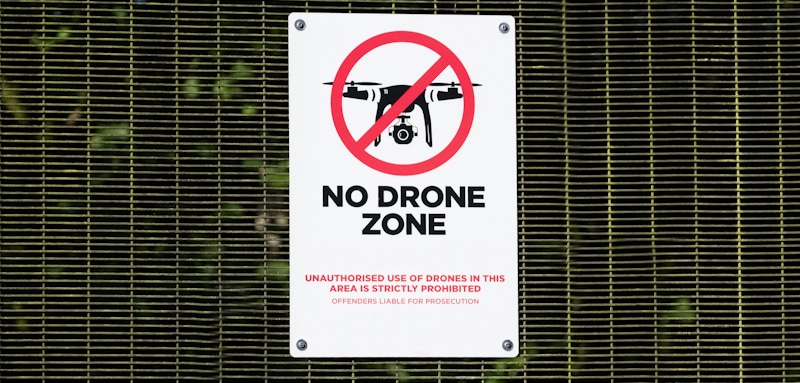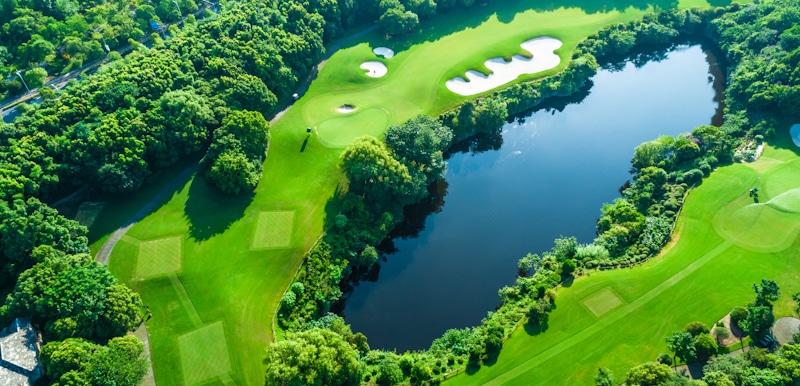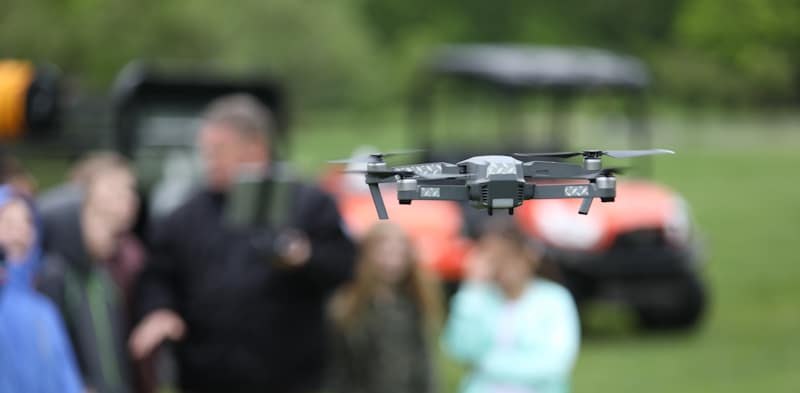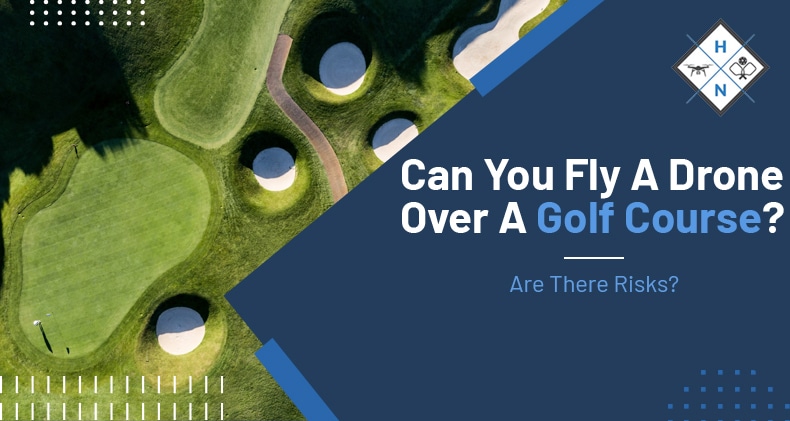Now that you have a drone you'll want to experience flying it in different places. One of the places you may want to try flying your drone is over the top of a golf course. Of course, you want to make sure that you know that you're flying in places where it's legal to fly.
It is completely legal for you to fly your drone over the top of a golf course. However, you should get management's permission first because this is private property. You also need to be careful of things like golf balls sailing through the air while you're flying your drone.
Golf Courses Located in No-Fly Zones
In order to know whether a golf course is located in a no-fly zone, it's important to first understand what's meant by a no-fly zone. This is an area that the FAA (Federal Aviation Administration) has said aircraft aren't permitted to fly. There are several of these areas located throughout the United States and if a golf course should happen to fall within one of them you won't be able to fly your drone there. These areas include airports, Washington D.C., sports arenas, wildlife refuges, national parks, military bases, and prisons.

How to Tell if a Golf Course is in a No-Fly Zone
Since the FAA is responsible for controlling all aerial traffic within the United States, it's up to them to make rules and regulations regarding aerial vehicles, including drones. When you want to know whether or not a golf course is located in a no-fly zone you can use the FAA's B4uFly app on your smartphone. This will tell you when and where you can fly, as well as if the golf course is off-limits for drone flight. Typically this will only happen when a golf course is located near an airport (which unfortunately a lot of golf courses are located near airports) since there aren't any laws specifically stating that you can't fly your drone over a golf course. If you're still interested in flying your drone near an airport you'll need to use the LAANC (Low Altitude Authorization and Notification Capability) system to request permission to do so.
When you discover that you need to use LAANC to get permission to fly on a golf course, there are a few things you should know about this system. One of the main things that's important for you to understand here is that when you receive permission from LAANC you'll be operating your drone under either the Small UAS Rule Part 107 or under the exception for Recreational Flyers. To receive your authorization to fly in this airspace you'll need to use one of the approved apps (e.g. Aeronyde, Airmap, Airspacelink, AiRXOS, Altitude Angel, Kittyhawk,
Skyward, Thales Group) since everything is handled in near real-time. In doing so you'll be required to designate the altitude ceiling for flying your drone. If you want to be able to fly your drone at over 400 feet you'll need to register your drone with the FAA 90 days in advance of your flight and hold a Remote Pilot Certificate.
Even when you're sure that you've cleared all the legalities regarding your flight, flying your drone over a golf course is still somewhat of a grey area because they're considered private property – an area that's owned by a specific group or club. Flying your drone over private property is somewhat tricky since there's always the possibility that doing so could end badly. This is why you should always talk to the owner of the golf course before you launch your drone on their property.
You may come across some golf course managers who don't want you to fly your drone over their property because they want to ensure that the people who are golfing there can have quiet enjoyment of the property. They may also feel that the noise that drones make while flying could distract people from their game – something that many golfers would probably then lodge a complaint about.
There are also golf course members who welcome drone use over their facility because their guests and members are intrigued by them. Drones will undoubtedly build excitement because people will enjoy watching them fly by. Managers who realize this also understand that when drones are present on their golf course it gives people something to talk about – a way to remember their experience on this golf course in the future.
Flying Drones Over Private Property
Once you've made sure that the golf course where you want to fly your drone isn't located within a no-fly zone, you must still realize that it is considered private property. This isn't something you need to worry about getting into trouble with the law unless the golf course manager calls the police and reports you for trespassing. As far as the FAA is concerned though, as long as you're flying under 400 feet the airspace is unregulated. Of course, you should also check with your local and state laws as some do prohibit flying a drone over private property.
How Drones are Being Used on Golf Courses Today
Not only do people want to fly their drones over golf courses for recreational purposes but many golf courses are now using them as a commercial tool too. There are a lot of drones throughout the United States today that are doing this because there are many purposes and advantages to doing so. This includes everything from marketing to planning or maintaining the course.

One of the main reasons why drones are being used more frequently in capturing the beauty of a golf course in photographs is that it's very easy to do so. This beauty is oftentimes overlooked when someone is simply given a ground tour of the golf course. However, an owner can really show off their course's beauty when videos and photographs are captured from the sky. Now that drones are able to capture inexpensive, high-quality videos many golf courses are choosing to hire them to do so.
This is something that due to growing demand is also growing much more affordable for golf course owners to do today. In fact, a professional-quality drone could easily start at only $900 which is a price that even a small golf course could afford, especially if you pause for just long enough to consider how many times the seasons change and the fact that you'll want to use your drone to capture footage throughout each of these seasons. Even if a golf course decides to hire a drone pilot to take these photographs for them it's still less expensive than what they'd have paid a helicopter to do it for them.
Another popular use for drones on golf courses today is the creation of photogrammetry maps. These maps play an important role in capturing photographs from which accurate measurements can be taken. Two of the drones that can provide you with the highest quality images at the most affordable prices are the Mavic 2 Zoom and the Phantom 4. However, if you don't mind investing some additional money here you may want to opt for the DJI Inspire 2 equipped with the Zenmuse X7 camera.
With these drones, golf courses can create waypoints that can be followed autonomously, capturing videos every second along the way. Specialized photogrammetry software can then use these photos to create a 3D map of the golf course. Such maps are beneficial when there's flooding or other issues that may arise. Sometimes these drones take photographs of the area that are then used in constructing the actual golf course. This allows the architects to maintain some of the beauty of the surrounding area since it can be taken into consideration and plans can be made accordingly.
When a drone pilot is able to customize their drone to fly at a high speed they can then follow a golf ball once it's been hit up until the point where it lands in the hole. This can lead to some amazing-looking shots being captured. While some golfers will appreciate these as mementos of their time on the golf course, commercial uses for these images also exist.
Tips for Flying Drones on Golf Courses
Just because you've been able to find a golf course that'll allow you to fly your drone doesn't mean that you should fly it there. Flying your drone over a golf course can be both challenging and dangerous even for the most highly qualified and skilled drone pilot.
While it's illegal to ever fly your drone above 400 feet you may be tempted to do so here. At the very least, you'll want to fly higher than you would normally fly since most golf balls can reach a height of 76 feet in the air when hit by a good swing. Remember that regardless of how high you fly (within legal limits), you must always maintain your drone within your line of sight.
Another important rule that all drone pilots must abide by has to do with respecting people's privacy while flying your drone. This means that you should never fly your drone over groups of people, public events, or stadiums full of people. If you're on a busy golf course, this may be somewhat challenging for you to do. Nevertheless, you must still avoid people while flying your drone.

Of course, you're also responsible for abiding by all other laws regarding flying your drone. This is why you should also take a moment to make yourself aware of FAA Airspace Restrictions before launching your drone. You should also understand what the rules of golf course etiquette dictate. For instance, you should never fly your drone during a round because its noise can be distracting to the golfer unless you're flying really high (remember, you'd need clearance from the FAA to be allowed to do this). This is why most drone photographers will typically capture landscape still shots that don't disturb the golfers.
Conclusion
If you still want to try flying your drone over the top of a golf course, there's no reason why you can't do so. Just make sure that the management gives you permission to take off and land on their property since it is considered "private property." Also, make sure that you're careful about some of the other dangers you may encounter while flying there – like golf balls soaring through the air. Otherwise, have fun flying your drone over the top of a golf course.
Shawn Manaher loves to play with new toys and dive into new hobbies. As a serial entrepreneur, work definitely comes first but there is always room for hobbies.

